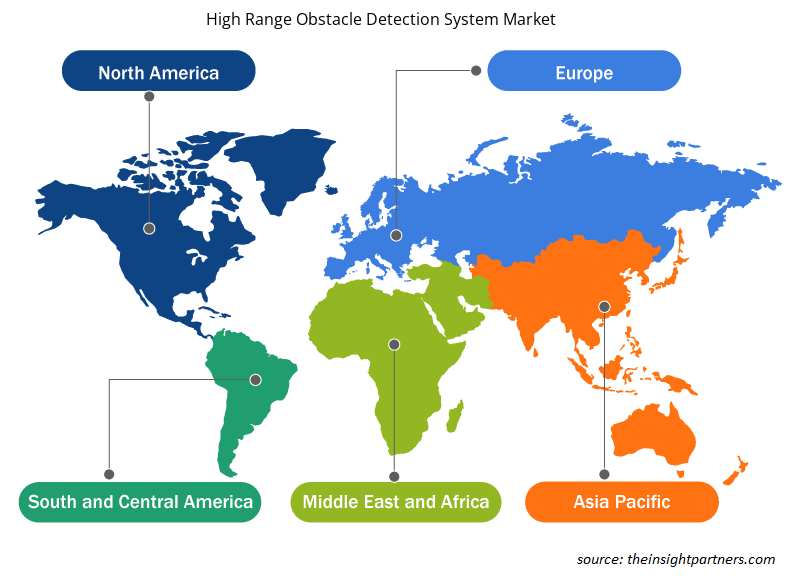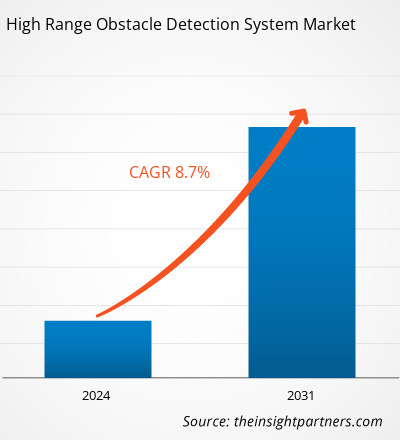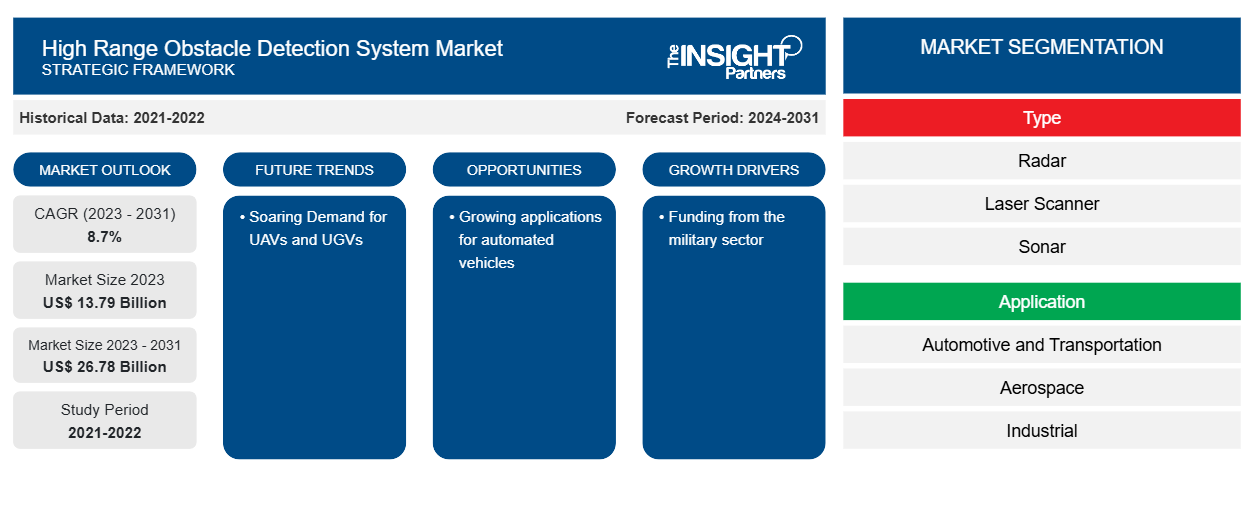Si prevede che la dimensione del mercato dei sistemi di rilevamento ostacoli ad alto raggio raggiungerà i 26,78 miliardi di dollari entro il 2031, rispetto ai 13,79 miliardi di dollari del 2023. Si prevede che il mercato registrerà un CAGR dell'8,7% nel 2023-2031. La crescente domanda di sistemi efficienti di rilevamento ostacoli nel settore automobilistico e l'adozione della tecnologia LiDAR in vari settori rimarranno probabilmente fondamentali per le tendenze del mercato dei sistemi di rilevamento ostacoli ad alto raggio.
Analisi di mercato del sistema di rilevamento ostacoli ad alta portata
Si prevede che il mercato globale dei sistemi di rilevamento ostacoli ad alto raggio si espanderà rapidamente grazie alla sua applicazione in una varietà di settori verticali, tra cui automotive, robotica, aerospaziale e difesa. Alcuni dei principali fattori che guidano la crescita del mercato globale dei sistemi di rilevamento ostacoli ad alto raggio includono la crescente domanda di veicoli autonomi e una maggiore necessità di rilevamento delle collisioni. Si prevede che i progressi tecnologici nei sensori e nei componenti correlati creeranno opportunità significative per i partecipanti al mercato.
Panoramica del mercato dei sistemi di rilevamento ostacoli ad alto raggio
Un rilevamento affidabile degli ostacoli ad alto raggio è fondamentale per le piattaforme in rapido movimento e critiche per la sicurezza, come le auto autonome, per rispondere ai pericoli in tempo reale. Un sistema di rilevamento degli ostacoli ad alto raggio rileva ostacoli come alberi ed edifici da lontano. Funziona utilizzando sensori come radar, telecamere e laser per misurare l'altezza e gli oggetti nell'ambiente e avvisare l'utente quando viene rilevato un ostacolo. Questi sistemi sono utilizzati in una varietà di applicazioni, tra cui la navigazione di veicoli e aerei, il rilevamento militare, l'evitamento delle mine antiuomo e altri.
Personalizza questo report in base alle tue esigenze
Riceverai la personalizzazione gratuita di qualsiasi report, comprese parti di questo report, o analisi a livello nazionale, pacchetto dati Excel, oltre a usufruire di grandi offerte e sconti per start-up e università
-
Scopri le principali tendenze di mercato in questo rapporto.Questo campione GRATUITO includerà analisi di dati che spaziano dalle tendenze di mercato alle stime e alle previsioni.
Driver di mercato e opportunità per i sistemi di rilevamento degli ostacoli ad alta portata
Finanziamenti dal settore militare per favorire il mercato
Il sistema di rilevamento ostacoli ad alto raggio è un sofisticato sistema di rilevamento che utilizza sia tecnologie radar che visive per rilevare ostacoli e pericoli da una lunga distanza. Viene utilizzato in applicazioni militari, come droni, veicoli terrestri e navi. Questo sistema utilizza sensori avanzati che aiutano a rilevare gli ostacoli in tempo reale. Tale tecnologia avanzata aiuta a migliorare l'efficienza di droni, veicoli di superficie senza pilota ( USV ) e altri. Per tale utilizzo di questa tecnologia nel settore militare, gli operatori di mercato sono finanziati dai militari per sviluppare soluzioni tecnicamente avanzate. Ad esempio, nel dicembre 2023, KEF Robotics ha ricevuto finanziamenti dal Dipartimento della Difesa degli Stati Uniti per sviluppare una soluzione di rilevamento ostacoli abilitata all'intelligenza artificiale per i droni vincolati dell'esercito americano.
Crescenti applicazioni per veicoli automatizzati
Esiste un mercato crescente di veicoli automatizzati e sistemi di guida autonoma in quanto rappresentano un trasporto più sicuro ed efficiente. I veicoli automatizzati generano la domanda di sistemi di rilevamento ostacoli, che promuovono ulteriormente la domanda di sistemi di rilevamento ostacoli ad alto raggio per ottenere un rilevamento accurato degli ostacoli. Con l'adozione di questa soluzione, il veicolo rileva rapidamente gli ostacoli e reagisce di conseguenza. Questa caratteristica migliora la sicurezza dei veicoli autonomi.
Analisi della segmentazione del rapporto di mercato del sistema di rilevamento degli ostacoli ad alta portata
I segmenti chiave che hanno contribuito alla derivazione dell'analisi di mercato dei sistemi di rilevamento ostacoli ad alto raggio sono tipologia e applicazione.
- In base al tipo, il mercato è segmentato in radar, scanner laser , sonar e LiDAR. Si prevede che il segmento LiDAR crescerà con il CAGR più elevato.
- Per applicazione, il mercato è segmentato in automotive e trasporti, aerospaziale, industriale, marino e altre applicazioni. Il segmento automotive e trasporti ha detenuto una quota di mercato maggiore nel 2023.
Analisi della quota di mercato dei sistemi di rilevamento degli ostacoli ad alto raggio per area geografica
L'ambito geografico del rapporto di mercato sui sistemi di rilevamento ostacoli ad alto raggio è suddiviso principalmente in cinque regioni: Nord America, Asia Pacifico, Europa, Medio Oriente e Africa e Sud America/Sud e Centro America.
Si prevede che la regione Asia-Pacifico crescerà con il CAGR più elevato. Il mercato del rilevamento ostacoli ad alto raggio sta crescendo nella regione con l'aumento dell'uso di robot industriali. L'ampia applicazione del rilevamento ostacoli ad alto raggio nei veicoli autonomi e nei droni ne favorisce ulteriormente la crescita di mercato.
Approfondimenti regionali sul mercato dei sistemi di rilevamento degli ostacoli ad alta portata
Le tendenze regionali e i fattori che influenzano il mercato dei sistemi di rilevamento ostacoli ad alta portata durante il periodo di previsione sono stati ampiamente spiegati dagli analisti di Insight Partners. Questa sezione discute anche i segmenti e la geografia del mercato dei sistemi di rilevamento ostacoli ad alta portata in Nord America, Europa, Asia Pacifico, Medio Oriente e Africa e America meridionale e centrale.

- Ottieni i dati specifici regionali per il mercato dei sistemi di rilevamento ostacoli ad alto raggio
Ambito del rapporto di mercato sui sistemi di rilevamento degli ostacoli ad alta portata
| Attributo del report | Dettagli |
|---|---|
| Dimensioni del mercato nel 2023 | 13,79 miliardi di dollari USA |
| Dimensioni del mercato entro il 2031 | 26,78 miliardi di dollari USA |
| CAGR globale (2023-2031) | 8,7% |
| Dati storici | 2021-2022 |
| Periodo di previsione | 2024-2031 |
| Segmenti coperti |
Per tipo
|
| Regioni e Paesi coperti |
America del Nord
|
| Leader di mercato e profili aziendali chiave |
|
Densità degli attori del mercato: comprendere il suo impatto sulle dinamiche aziendali
Il mercato dei sistemi di rilevamento ostacoli ad alto raggio sta crescendo rapidamente, spinto dalla crescente domanda degli utenti finali dovuta a fattori quali l'evoluzione delle preferenze dei consumatori, i progressi tecnologici e una maggiore consapevolezza dei vantaggi del prodotto. Con l'aumento della domanda, le aziende stanno ampliando le loro offerte, innovando per soddisfare le esigenze dei consumatori e capitalizzando sulle tendenze emergenti, il che alimenta ulteriormente la crescita del mercato.
La densità degli operatori di mercato si riferisce alla distribuzione di aziende o società che operano in un particolare mercato o settore. Indica quanti concorrenti (operatori di mercato) sono presenti in un dato spazio di mercato in relazione alle sue dimensioni o al valore di mercato totale.
Le principali aziende che operano nel mercato dei sistemi di rilevamento ostacoli ad alto raggio sono:
- Sistemi BAE plc
- Blickfeld GmbH
- Azienda aerospaziale Collins
- Honeywell International Inc.
- ifm elettronica gmbh
- Livox
Disclaimer : le aziende elencate sopra non sono classificate secondo un ordine particolare.

- Ottieni la panoramica dei principali attori del mercato dei sistemi di rilevamento ostacoli ad alto raggio
Notizie di mercato e sviluppi recenti sui sistemi di rilevamento degli ostacoli ad alta portata
Il mercato dei sistemi di rilevamento degli ostacoli ad alta portata
viene valutato raccogliendo dati qualitativi e quantitativi post-ricerca primaria e secondaria, che includono importanti pubblicazioni aziendali, dati associativi e database. Di seguito è riportato un elenco degli sviluppi nel mercato:
- A maggio 2023, il Bosch Engineering Center di Cluj ha annunciato l'installazione di un sistema di avviso di collisione sviluppato da Bosch denominato Tram Forward Collision Warning (TFCW) su un tram che fa parte della flotta della Cluj-Napoca Public Transport Company (CTP). Il sistema assiste i conducenti del tram in situazioni critiche fornendo avvisi acustici e visivi, migliorando così la sicurezza per i conducenti del tram, i passeggeri e gli altri partecipanti al traffico. Il sistema di avviso di collisione del tram supporta i conducenti in situazioni critiche avvisandoli tempestivamente degli ostacoli sui binari, in particolare in condizioni di traffico congestionato o visibilità ridotta. Ciò consente ai conducenti di evitare incidenti o ridurre significativamente i danni. (Comunicato stampa, 2023)
Copertura e risultati del rapporto di mercato sui sistemi di rilevamento degli ostacoli ad alta portata
Il rapporto "Dimensioni e previsioni del mercato dei sistemi di rilevamento degli ostacoli ad alto raggio (2023-2031)" fornisce un'analisi dettagliata del mercato che copre le seguenti aree:
- Dimensioni del mercato e previsioni a livello globale, regionale e nazionale per tutti i segmenti di mercato chiave coperti dall'ambito
- Dinamiche di mercato come fattori trainanti, vincoli e opportunità chiave
- Principali tendenze future
- Analisi dettagliata delle cinque forze PEST/Porter e SWOT
- Analisi di mercato globale e regionale che copre le principali tendenze di mercato, i principali attori, le normative e gli sviluppi recenti del mercato
- Analisi del panorama industriale e della concorrenza che copre la concentrazione del mercato, l'analisi della mappa di calore, i principali attori e gli sviluppi recenti
- Profili aziendali dettagliati
- Analisi storica (2 anni), anno base, previsione (7 anni) con CAGR
- Analisi PEST e SWOT
- Valore/volume delle dimensioni del mercato - Globale, Regionale, Nazionale
- Industria e panorama competitivo
- Set di dati Excel
Report recenti
Testimonianze
Motivo dell'acquisto
- Processo decisionale informato
- Comprensione delle dinamiche di mercato
- Analisi competitiva
- Analisi dei clienti
- Previsioni di mercato
- Mitigazione del rischio
- Pianificazione strategica
- Giustificazione degli investimenti
- Identificazione dei mercati emergenti
- Miglioramento delle strategie di marketing
- Aumento dell'efficienza operativa
- Allineamento alle tendenze normative























 Ottieni un campione gratuito per - Mercato dei sistemi di rilevamento degli ostacoli ad alta portata
Ottieni un campione gratuito per - Mercato dei sistemi di rilevamento degli ostacoli ad alta portata